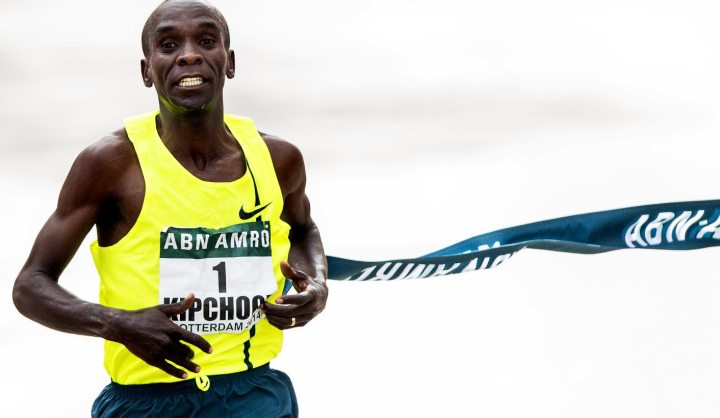South Africa, Sport
#Breaking2: Everything you need to know about three runners attempting the sub-two marathon

Over the weekend, three elite runners will attempt something experts predicted will only happen in 2075. Every single detail has been controlled and even if you have nothing more than a passive interest in running, the test of human physiology should be enough to entice you to watch. By ANTOINETTE MULLER.
What is it?
For the average runner, the thought of completing a marathon in two hours is unfathomable. For elite runners, this is the pinnacle of achievement. It’s not happened to date, but progression in sports science means that athletes have been getting closer to that mark. The current world record, set in Berlin back in 2014, is two hours, two minutes, 57 seconds. It’s held by Kenya’s Dennis Kimetto and when he set it, it was a whole four minutes faster than the previous record from 1998. Before that, the marathon world record had been stuck at 2:06:50 since 1988.
Four minutes. What can an ordinary person do in four minutes? It seems like so little time, but for top athletes, it might as well be a whole turn around the sun.
This weekend, three elite runners will try and shave those final few minutes off the clock. It is an incredible effort of human ability. To achieve their target, runners will have to run 4:34 or faster per mile (1.6km). To put into context just how small seconds are, Kimetto’s record was run at 4:41 per mile. Everything is fractional.
The challenge is even more impressive when reading this fascinating piece from Runner’s World, publish in 2014. Having crunched mountains of data, the publication predicted that the sub-two hour will only happen in 2075 – and it will probably happen in March or November.
None of those factors are at play over the weekend.
The attempt is backed by Nike and cynics say it’s nothing more than a marketing gimmick. The sports giant, of course, insist that it’s about how a combination of talent,
Who is running it?
Kenya’s Eliud Kipchoge, 32, last year’s Olympic marathon gold medallist and former 5000m world champion, who has a PB of 2:03:05 – the third-fastest in history.
Eritrea’s Zersenay Tadese, 35, current half-marathon world record holder with 58:23 minutes
Ethiopia’s Lelisa Desisa, 26, with a marathon PB of 2:04.45.
Does anybody actually have a chance?
The majority of experts say “no way”, but if anyone is going to do it, it’s going to be Kipchoge.
Where is it taking place?
The runners will run about 17 laps of a 2.4km loop that forms part of the Monza F1 track in northern Italy.
What time is it?
Things will get going at 5.45am SAST.
Where can I watch it?
Live streaming on Nike’s social media profiles. Here’s the trailer.
Breaking the 2-hour marathon. Crazy? Yes. So we’re doing it. #LIVE
Retweet or ? for @Nike #Breaking2 notifications. pic.twitter.com/Ue5Tvu3YCe
— Nike (@Nike) May 5, 2017
The athletes who are taking part are some of the best in the world. The attempt to explore what is possible for the human body will make for an intriguing discussion philosophically, technologically, and physiologically.
Much about this is incredibly scientific. Nike is asking the question of what is possible and what factors contribute to making it so? We have all heard that genetics might play a role in being a really good long-distance runner, but scientific data is actually inconclusive on this.
Instead, scientists suggest that the following three factors play a role when it comes to running: oxygen consumption, lactate threshold, and running efficiency. Two out of three can be improved through training. Train at high altitude and your oxygen consumption will be better – which is why it’s hardly a surprise that the three runners are all from high-lying areas.
Resistance and interval training will aid with lactic acid, but scientists do not believe that running efficiency – basically how much energy you use when pounding the pavement – can’t be improved no matter how hard you train. It is so specific to each person and contributing factors affect each person differently. It’s why some athletes swear by carbo-loading while others do actually function better when fuelled by fat.
Nike has made every effort to ensure that every single detail has been controlled to ensure the perfect race. That includes the training and the energy efficiency of their runners. A team of scientists has made recommendations on how much, when and what sort of food each runner should consume to help them get through the race.
Data on what exactly happens to the physiology of marathon and ultra-marathon runners in the latter part of their races are also not understood fully yet. Studying this in
And then there’s the gear. The project coincides with the launch of a new shoe. Lightweight and fitted with a carbon-fibre plate, it’s the latest piece of kit that claims to aid runners in being better at what they do. Of course, much like every other piece of fancy kit, simply lacing up with these isn’t going to take you from being sub-par to sub-two.
This is good for short-term interest in running and it will be interesting to see if any other big brands try something similar. However, it’s crucial to remember that running – and the magic of marathons – thrives on the stories that come out of the unknown, the struggles of bad weather days and the rookies who shoot out of nowhere.
Photo: Kenya’s Eliud Kipchoge crosses the finish line to win the Rotterdam Marathon in Rotterdam, Netherlands, 13 April 2014. EPA/KOEN VAN WEEL

















 Become an Insider
Become an Insider